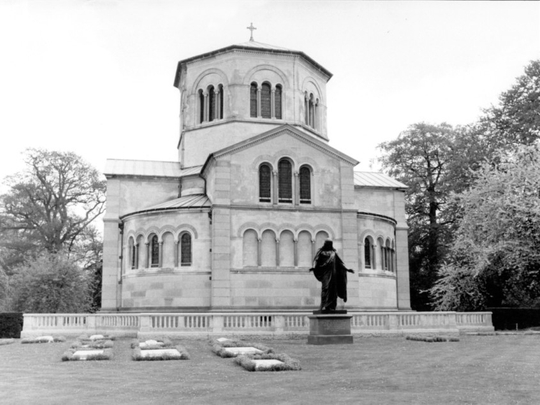
London: Frogmore is the royal family’s secret bolt-hole, tucked away in Windsor Castle’s Home Park.
It’s where the Queen walks her corgis; where Prince Philip installed the dining room from the royal yacht, Britannia. Prince Charles gets his Highgrove mulch from Frogmore, while Prince Andrew and Prince Edward used it as a secluded playground for their children.George VI and the Queen Mother spent their honeymoon at Frogmore in 1923. The 14-hectare gardens are only a kilometre from Windsor Castle, but their hush and emptiness are a million kilometres from Windsor’s pomp and circumstance — and its tourists.
Frogmore is off-limits to the public, except for three days this week, when it opens for charity. Frogmore is also the Royal Family’s hidden burial ground. Most of Britain’s monarchs are buried in Westminster Abbey and St George’s Chapel, Windsor. But Queen Victoria was buried, alongside Prince Albert, in a northern Italian Romanesque mausoleum at her beloved Frogmore.
“She chose to be buried at Frogmore because it was the shrine she herself had built for the angel — Prince Albert,” says A.N. Wilson, Queen Victoria’s biographer. “She liked having created Frogmore. It was just him and her, which is the way she liked it. At Westminster, she would have been with all the other old queens and that would not have suited her style at all.” Nearby is a circular, colonnaded mausoleum for Queen Victoria’s mother, the Duchess of Kent, who lived at Frogmore.
Like Prince Albert, she died in 1861, the bleakest of years for Victoria. Visitors can’t go inside the mausolea, but they can view them up close from the outside. They can also see, from a roped-off distance, the Royal Burial Ground.
Here lie the Duke of Windsor and Wallis Simpson. Here, too, is Angus Ogilvy, Princess Alexandra’s husband, and the Duke of Kent — father of the current Duke of Kent — killed in an RAF crash in Caithness in 1942. If Windsor wasn’t just up the road, then Frogmore House would be more celebrated. Built in 1680 by Charles II’s architect, Hugh May, the house is packedwith mementos, not least the Britannia Room, formerly the dining room for Queen Victoria’s mother.
When the royal yacht, Britannia, was decommissioned in 1997, Prince Philip took its dining room furniture to Frogmore. The Hepplewhite dining chairs from Britannia are here, as is the mahogany dining table made for the yacht, and four sideboards, by Waring & Gillow, from the previous royal yacht, Victoria & Albert III. Frogmore’s garden was commissioned by Queen Charlotte in 1792 as an exercise in the fashionable picturesque style.
Today, it retains its combination of serpentine lake, island and follies, topped up with later royal additions. In one spot, there are three golden Gleditsia trees, given by the Duke of Westminster to celebrate the Queen’s golden wedding anniversary in 1997.
In 2012, the Queen’s Diamond Jubilee, the Swiss Seat, a Swiss cottage made out of silver birch branches in 1833, was renovated. Still, today, the Queen gives gardening suggestions to Frogmore’s head gardener, Neil Dodds, who has tended the garden for 35 years.
Between him and four other gardeners, they have notched up more than a century at Frogmore. Frogmore’s garden fell into disrepair in the early 20th century, when the lawns were smothered in dense thickets of evergreen.
Indian kiosk
In 1977, the Queen’s Silver Jubilee, the garden was revitalised. It is now crammed with orchids, rhododendrons, camellias, lilacs, Ceanothus, hellebores and dogwoods, alongside a 30-year-old redwood, Victorian plane trees and ancient oaks.
“It’s a spring garden, designed to be at its best in April when the Queen is in residence — the wisteria, daffodils and cherry trees are particularly good,” says Dodds. “Her Majesty takes a great deal of interest in the garden. And the Duke is very hands-on, too.”
Everywhere you walk at Frogmore, you feel you’ve penetrated the monarchy’s inner sanctum. In one corner of the garden, there’s a granite drinking fountain, raised by Queen Victoria to her adored servant, John Brown. The inscription reads, “In affectionate remembrance of John Brown, Queen Victoria’s devoted personal attendant and friend, 1883. Remember what he was with thanking heart/The bright, the brave, the tender and the true.”
Right next to the John Brown drinking fountain is Queen Victoria’s tea house, built in 1870: two half-timbered, connected pavilions, topped with tiles and enormous chimneys, and wrapped in wisteria. She also erected an onion-domed, Indian kiosk in white marble, presented to her in 1858 by Lord Canning after the Indian Mutiny. Frogmore House and gardens was open to the public from June 7 to 9.
— The Telegraph Group Limited, London 2016












